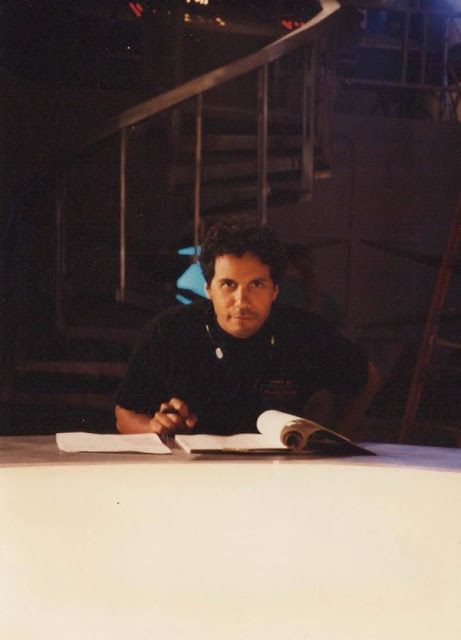
Director King Wilder on the set of Ultraman: The Ultimate Hero. Photo © Julie Avola.
King Wilder may have directed all 13 episodes of the made-in-America series Ultraman: The Ultimate Hero (1993), but his involvement in the entertainment industry stretches far beyond that. Born in Los Angeles in 1958, Mr. Wilder lived most of his early life in Long Island, New York. In 1986, he secured a job as location manager on Don Coscarelli’s Survival Quest. Following his break in the business, Mr. Wilder was hired at Empire Productions (which specializes low-budget, straight-to-video horror movies) as an assistant editor and then editor for the company’s feature films. In 1990, Mr. Wilder co-produced Puppet Master II for Empire Productions, for which he is probably best known. In 1992, Mr. Wilder was introduced to Ultraman: The Ultimate Hero and was offered the job of making the series with his producer-wife, Julie Avola. His love for the Japanese sci-fi genre made him eager to be a part of the project. In 2006, Mr. Wilder shared his memories of shooting Ultraman: The Ultimate Hero with Brett Homenick.
Brett Homenick: Were you a fan of Ultraman, or even Godzilla, growing up?
King Wilder: Godzilla. I didn’t really know much about Ultraman when I got on the project. I remember seeing that there was the Australian Ultraman (Ultraman: Towards the Future, a.k.a. Ultraman Great). But I didn’t really know much more about it.
BH: But you were a fan of Godzilla?
KW: Yeah, not a die-hard fan, but I used to love watching the movies.
BH: Do you have any favorites that you remember to this day?
KW: No, not really. I think just after we did Ultraman, some of the Japanese guys worked on some of the later versions of the Godzilla movies that had some better production values and things that were cool. But I liked some of the earlier ones, Mothra, just because they were classic, and they had a great score. That and “King Ghidrah.”
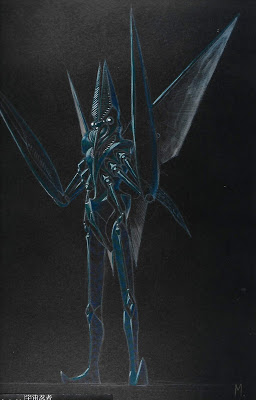
Concept art for Baltan Seijin provided by Tsuburaya Productions. Photo © Tsuburaya Productions.
BH: How did you get involved in Ultraman: The Ultimate Hero?
KW: A Japanese friend of mine, who I play golf with, just came to me one day and asked me if I wanted to work on the show. He came to my wife because my wife was a producer at the time. I was the director side of our team. He came to her and wanted to know if she’d be interested in producing the series. She said she would, so then I was brought in on it also. This is back probably (in) early ’92.
We just went through some initial negotiations, just to see what was going to be the extent of the project and to see whether or not we were interested in doing it, based on what they were offering. One thing led to another, and the Tsuburaya people came out. We had meetings, and negotiations continued, and eventually got made. But there were some periods during the negotiations where my wife Julie (Avola) and I wanted to actually back out of the project for different reasons. (laughs)
BH: (laughs) Are those reasons you can talk about?
KW: Yeah, most of them were financial. None of them were financial for our salaries or anything like that, but financial for the amount of money that was being put into the project because what they wanted, and they stated this to us in one of our early meetings and a few of our subsequent meetings, was that they were happy to finally get the series done in America because they wanted to get the Terminator 2 type of special effects on it.
We were all great and happy, and we said, “Okay, fine. How much are you intending on spending on this thing?” The budget that they said that they were going to be giving us couldn’t even come close to what they really wanted. Their thing was that if it was made in America, then it was going to be great. To them, it really didn’t equate to the money that was being put into the project. So it was hard to convince them that the reason Terminator 2 looked so good is because it cost $90 million.
BH: (laughs)
KW: Of course it had a great director on it, but it was the money that was buying it. You couldn’t make that same film for $4 million. To them, it didn’t really sink in that well because they don‘t have the same type of thought process. Maybe they do now, but what they were telling us is that, for example, one day a crew member could be an electrician, the next day he could be props, the next day he could be a carpenter. There’s no set position for any one particular person on a crew in Japan. They don’t have the same kind of standards that are necessary or laws or pay scale, such as there was no need for a fire safety officer on any of their sets. It’s mandatory on any set in America, whether it’s union or nonunion, (to) have a fire safety officer if there’s going to be any kind of pyro. For a Godzilla or Ultraman type of show, there’s going to be pyro.

Concept art for Red King. Photo © Tsuburaya Productions.
So we told them that that has to go into the budget, and this and that, and so when they went over the budget, they didn’t like it because we had to put in a lot of things that we knew that we needed to have on an American production. They kept on saying, “Why do you need this? Why do you need this? Why do you need this?” We tried to explain it to them, as much as we could, because it was an American production. It’s not done the same way as it is in Japan. But these are things that you just cannot get around.
That was one of the reasons why negotiations almost broke down because we kept on saying, “If you guys don’t understand or can’t follow these rules the way it’s done in America, we just don’t want to be a part of it.” But I think they were so gung-ho in wanting to get this project off the ground that they were — not willing to make concessions, but willing to bend their way of thinking and maybe another way of doing it, and that would be the American way of doing it.
So I guess middle of ’92, toward the end of ’92, is when we actually got the green light to go forward, but we were really not pleased with the budget that we were getting. So we ended up making it on a shoestring. So probably, I would say, one-fifth the cost of the Australian Ultraman.
BH: Were you involved in the casting at all of the show?
KW: Yes, we were told that we could put together a cast, a certain number of selections, like three or four actors per part for the leads — not for the walk-ons, the day parts, but the leads. They would come back from Japan; we would all have an interim casting session with the Japanese Tsuburaya people. They would actually make the final decision on the particular actor in that particular role for the five leads. Except for Kane. Kane Kosugi was locked in there from the beginning. The other parts were through a little casting session.
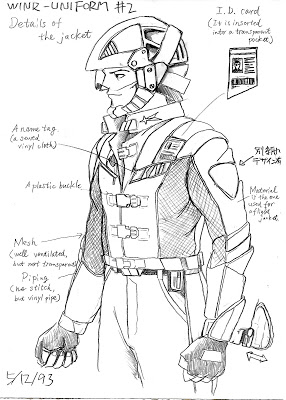
Design sketch for the WINR uniform. Photo © Tsuburaya Productions.
BH: How did you get along with the cast? How’d you get along with all those actors?
KW: Great. I mean, they were really good actors. Occasionally, there would be sometimes a little bit of an attitude from somebody here. But that’s kind of typical on any kind of production. It was no more than anything else. But everybody was great, and of course some people had problems with some of the technical dialogue because we tried to make it as fun and technospeak as possible, and (for) some people, it just didn’t roll off the tongue. But otherwise, it was fine. I wish we could have spent more time on the acting part of it, but we just didn’t have the time or budget.
Do you know how we actually ended up having to shoot it? Because it was 13 episodes, we could not shoot it in 13 consecutive episodes. You know how a regular motion picture is shot, out of order?
BH: Right.
KW: We had to shoot all 13 episodes like a 6 ½ -hour feature film instead of 13 separate stories. So we had two weeks of photography when I first started of just episode 1, 2, and 3 monsters. Then we had, I think, 15 weeks of principal photography with actors. Then I think three or four weeks at the end of the production with the rest of the monsters for all 13 episodes. So as you can picture that kind of logistical nightmare because we shot the first three episode monsters right off the start. Then we shot 15 weeks for principal photography where I knew where I shot the monsters for the first three episodes, and when the actors are supposed to react to them, I can keep eye lines and everything going in the same direction. But once we got past the first three episodes, the monsters for every episode after that had not been shot yet.
So I had to have an extremely concise — well, not even storyboards, just notes in my script because we didn’t even have money for storyboards — so that there was eye line and just about every piece of dialogue that had to do with the monster and every piece of action that had to do with a monster. So I just had to try to keep everything.

Design sketch for the WINR helmet. Photo © Tsuburaya Productions.
By the way, we were originally going to have 13 episodes consecutively shot and then 13 directors. But when they told us what the budget was, we told them that wasn’t possible to do. We couldn’t afford 13 directors. We couldn’t afford the period of time that it would take to do all that. The only way that we could make it cost-effective for what they would pay us for the production was to shoot it like a film, and shoot out all the similar locations at once.
So when we’d have the Command Center scenes, we’d shoot six weeks of that. Everything that was in and around the Command Center, we’d shoot that whole set out for the entire series, and then go on location to shoot other different locations. So we’d shoot every single location out, with every actor, and then move on to another location. So the logistics, for any given day, we were shooting bits and pieces of four or five different episodes. We’d have to remember wardrobe, eye line, makeup and hair — everything for the whole thing. It was a logistical nightmare. So personally, I am surprised, because I ended up having to direct them all, that it actually cut together. After I did that, I felt I could pretty much direct anything.
BH: (laughs)
KW: So that’s how the production went, and then it was almost nine months or close to a year to actually go and finish post-production and then deliver the product.
BH: Well, you talked about working with the Japanese side when it came to negotiations, but did you have much interaction with the Japanese side of things when it was actually in production?
KW: A little bit. There were a few technical representatives that were on the set every day and a couple still photographers that were on the set every day or almost every day. So we made friends with these guys for the entire production. But only occasionally did the financiers and Tsuburaya come out and visit the set to do things like that. But we had some of the Japanese guys out there all the time, so we had Japanese food a lot. (laughs)
BH: (laughs) So they were pretty much hands-off when it came to the actual filming of the show?
KW: Yes, and personally in a way, I regret that because a few of the technical guys were really, really good at what they did. But we just didn’t have the financial resources to split the production to let them do part and for us to do part. I probably could have used their advice a little bit more, shooting some of the monster scenes. But again, we were in situations where we would have to shoot out complete monster sequences almost two times a day. We didn’t have the budget to achieve the action they can get in Japan for the same money.
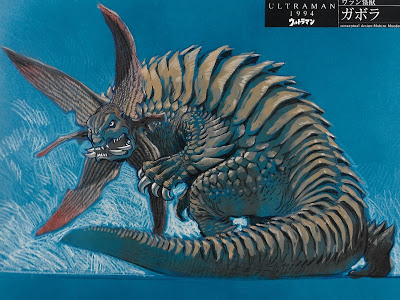
Concept art for Gabora. Photo © Tsuburaya Productions.
BH: That actually reminds me of something that I wanted to ask you. One of the criticisms of show is that the monster scenes don’t contain as much action as some of the original Japanese versions of the show. Is that because shooting was so constrained that there wasn’t much time to really choreograph the fight scenes?
KW: Yes, that was one of the things, and also I think there was, unfortunately, more of a sense of making the creatures look exactly the way the drawings were given to us because the Japanese gave us drawings for pretty much everything — vehicles, the monsters, and all these things. We were more set on making them look as close as possible to the drawings — not necessarily to make them durable for fight scenes. They were made durable for fight scenes. But (the) Japanese didn’t always tell us how these monsters were supposed to fight. So it’s hard to say, “Okay, how is Ultraman supposed to fight Red King or Pestar?”
So I had to come up with, and a few of the stunt guys had to come up with, ideas to make the fights as exciting as possible for the time we had and for the restraints that we had in the costumes because these weren’t the same kind of costumes that are in Power Rangers that are really pretty durable. These were really foam latex type of costumes, and they did hold together, but the more they got slammed around, the more they got damaged. We really couldn’t fly a lot of the guys in suits. We just didn’t have the money for rigging. SAG stuntmen get paid for rehearsal, and the budget didn’t allow for much rehearsal.
BH: Another question I had was (about) some of the guest stars that appeared in the show, such as Bill Mumy from Lost in Space. How did their involvement come about, and were people like Bill Mumy good to work with? Were they fans of Ultraman?
KW: I think Bill Mumy was a fan of Ultraman. Our casting director, Aaron Griffith, suggested Bill, and we thought he was perfect for the part. I would just cast the others based on who I thought was best for the part. One of my favorite actors, George Lazenby from On Her Majesty’s Secret Service, came in and read for a part.
BH: Oh, really?
KW: Yeah, but he just wasn’t right for the part, so I didn’t cast him! There was another guy who came in and read, and he was perfect for the part, but he was a no-name. But I thought he was perfect. There was Rose Marie who came in and read, and she got the part for one of the episodes. I think it was in “DaDa” or something. But there were some actors who would talk about watching Ultraman when they were a kid and others who really didn’t know anything about Ultraman. So it was split, depending on who you talked to.
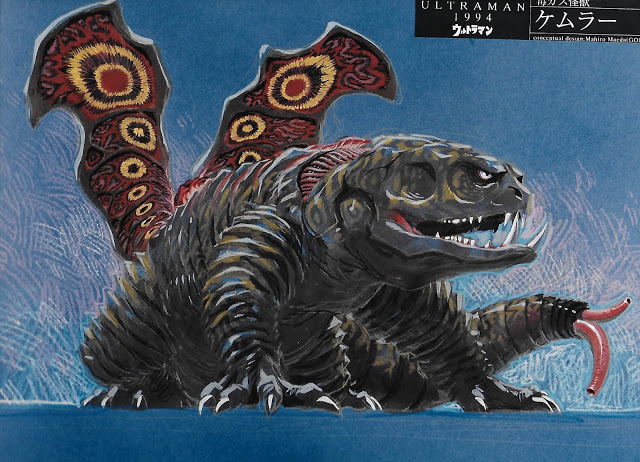
Concept art for Kemura. Photo © Tsuburaya Productions.
BH: I’m kind of interested in this. Do you remember offhand which part George Lazenby read for?
KW: Yes, I think it was episode 5, the Gaborah episode. No, I think it was Teresdon.
BH: With the people underground.
KW: Well, I think it also had to do with the nuclear radiation. Teresdon was with the nuclear radiation also, right? I think so.
BH: He might have been. It’s been a few months since I’ve seen the show. I just remember about Teresdon was that there were the mole people underground.
KW: Right. Oh, and by the way, two of those mole people…
BH: Are Kevin Hudson and Bruce Fuller.
KW: Right, you found that out.
BH: Yeah, they told me about that. But speaking of those two guys, what were they like to work with, or did you work with them much?
KW: They were great. They had a separate set-up, a complete different monster shop for them in a different location than where our office was. So they were a few miles away, but we did go over to their warehouse, to their studio, often once they were able to start building things. It was great. They did a great job.
Their entire crew were champing at the bit when we were first casting for the creature creators, Kevin Hudson and his crew, because they were all Ultraman fans, were all Godzilla fans, and it was one of their dreams to actually work on a Japanese type of movie. They’ll do the Batman suit or a Friday the 13th kind of thing, makeup effects, but it’s not the same as working on a Godzilla or Ultraman type of movie. They were all champing at the bit to work on it. So we got some really good work out of them. Then all the monsters, I think, look great. They may not be the most exciting fight scenes, but I think they all look really great. But they were great to work with.
BH: You talked about this a little bit, but was there anything particularly difficult to shoot on the series? I guess aside from the fight scenes or the monsters.
KW: Difficult, no. The first day of principal photography was different for me because the previous two or three weeks we were just shooting stunt guys in monster suits doing stunts, which was pretty good. They don’t have attitudes and everything like that. They just like to be flung around and fight. But then the first day of principal photography, there were a few bits of attitude and things, but also the thing that I realized right off the bat with principal photography was that all of a sudden, probably 60% of the shots that I wanted to shoot for any particular scene I had to throw out because we just didn’t have the time to shoot it.
So I had to completely rethink from that first day of principal photography all the way through the end the way I was going to shoot each scene. It couldn’t be as detailed or as exciting as I wanted it to be because instead of shooting maybe two pages a day, we were sometimes shooting 12 or 14 pages a day.
So I had to just rip things out and say, “Master, close-up, close-up. Let’s move on.” So that was probably one of the more difficult things. If you ever saw me on the set, I was hardly talking to anybody. I was always in my script, lining up the next shot, the next scene, working two or three scenes ahead. So that when we actually got there, I was prepared because we had to make our day every single day. For me, that was probably the hardest thing to do is just to stay on schedule. So it was just horrendous in that kind of schedule.
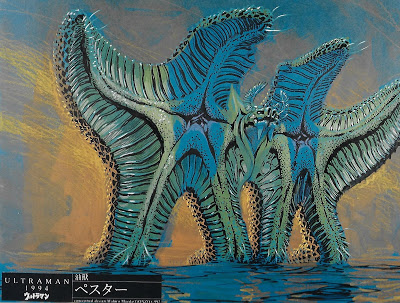
Concept art for Pestar. Photo © Tsuburaya Productions.
BH: Do you have any interesting stories from the set?
KW: Jeffrey Combs, do you know who he is?
BH: Yeah, he’s Re-Animator, correct?
KW: Right. He’s kind of a friend of ours because he’d worked on a bunch of films at Empire Productions when I was over there. So that’s why we wanted to hire him specifically for that episode. I think it was episode 3. He’s got that dry sense of humor. He’s got that really fun, comic way. When he was on the set, he made everybody laugh. He was a great time.
There were just some times where the set was really fun and light, and other times where it was kind of a bear. Some of the underwater scenes with the team in the sub were just a pain because it was hot in that little sub. We didn’t have the right special effects budget that we could do for the whole thing. Also, any of the days when they were in those Hawks. It was pretty much just the cockpit — that was all — and it was hot under that Plexiglas. There were complaints, so I had to make sure that I shot it as quickly as I could to get them out of there and then move on. But there was really no major disasters, none that I know of, that I can remember at all in the entire production.
One other thing I remember that was interesting, and eventually vital to our production, was that the Japanese gave us our budget in Japanese yen at the end of each week. We had to hope that the exchange rate moved in our favor, or we would be screwed. Luckily, the exchange rate did move in our direction for all the weeks but the first one or two weeks. This was enough to put the surplus cash back into the production, which was desperately needed. We sometimes got a lot extra because of the exchange rate, and that did help out.
BH: Maybe you can shed some light on this, but why do you think the series didn’t eventually air in America as it was planned to do?
KW: I know exactly why — because of a few things. This is one of the things during negotiations before we even got started is they wanted to go SAG, and they wanted to go union, the whole thing. We said, for the money that you are paying, we cannot do that because if we do that, then your monsters and your miniatures and everything else are going to suffer because we just don’t have the money.
So we said to them, “There’s also another consideration. If you guys actually go SAG, then you have to pay the actors’, stunt performers’, and puppeteers’ residuals whenever the product plays in another market than the original market. So if your original market is Japan, theatrical or video, and then you want to project it or display it overseas, like in America, you’re going to have to pay the actors again because it’s a SAG contract.” They all said, “Well, we don’t want to do that.” I said, “Great, we’ll go nonunion. We’ll save a lot of money on cast because this kind of series doesn’t need big-name SAG actors. It just needs good actors.” The monsters in Ultraman are really the star of the show, not the actors so much.
They said, “No, we need to go SAG.” (laughs) So we went back and forth with this, and we said, “Okay, final thing is, if you actually want to go SAG, you’re going to have to pay residuals.” “Well, we don’t want to do that.” So eventually they said, “We’re going to go SAG.” So we went SAG, and they said that they were just going to worry about that later, about paying residuals.
Their first market was for Japan, which means it’s free because they already paid the actors, but any other subsequent ancillary market is going to cost them money. I think they found that out when they finally tried to release it in English to America. They realized they were going to have to pay the entire cast, not just the five leads. But I think we had almost 80 day players in the entire thing. They had to pay each one of the actors residuals based on their scale, on their rate. They just didn’t want to do that. So I’m not 100% sure, but I would say I’m 90% sure that that is the reason why it never got released in America or maybe even outside of Japan.
Another reason is that 13 episodes are not enough for a season. They told us, after we negotiated the contract, that they wanted us to make 26 episodes. We said fine, we should readjust the budget you are giving us. They said “Why?” They didn’t know why we were asking for twice the original budget. We said, “Because we will be making twice the number of episodes.” It was just something they couldn’t understand, and they eventually backed out of making 26 episodes.
Also, the SAG actors would not sign away their rights to toys, games, media, etc. They explicitly had their contract say that the merchandising could not copy their likeness without being paid for it. The toy companies ended up making many action figures of the WINR team that looked like the cast. These toys were sold in Asia only.
So we were given LaserDisc versions of the show and videos, but they were all in English with Japanese subtitles because we recorded it in English. So I think there were actually some that I think they had dubbed in Japanese, but we never saw those. But as far as I know, that is the reason. I’m not sure if there’s any other reason. But as far as I know, that would be the reason.

Concept art for Zetton. Photo © Tsuburaya Productions.
BH: Overall, what did you think of the experience working on Ultraman: The Ultimate Hero?
KW: That’s a touchy question. (laughs) I enjoy directing that kind of show — action, fantasy, fun kind of things. But the overall experience wasn’t the one that I wanted to have with that show. I wanted to have something that was more fun and satisfying, and it really wasn’t. I really wasn’t having that much fun directing the thing at all just because I couldn’t enjoy it. I couldn’t try to compose shots like a regular film director would be. I would have to try to just grab the shots that I would need to satisfy the story and make sure I made my day every single day. We didn’t have the budget or a studio behind us that would say, “Okay, James Cameron, you’re a week over; we’ll give you another $35 million.” No, it’s not going to happen. They weren’t going give us another $5,000. Whatever our budget was, and whatever our schedule was, it had to be adhered to.
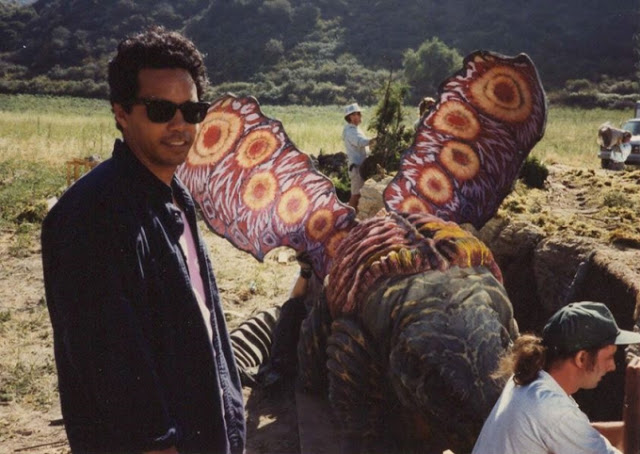
King Wilder confers with Kemura on set. Photo © Julie Avola.
So I would have liked to have spent a lot more time on the monster fights and have more interaction with the Japanese so that I could get that done better. But we just really didn’t have the time and money to do it all. But I did enjoy it a little bit, but I just wish the whole product came out a little bit better than it did. (laughs) I’m still frustrated that they would give $26 million or something, $30 million. I don’t even know what they gave to the Australians for their series, and they give us a tenth of that or whatever. So it was just really frustrating.